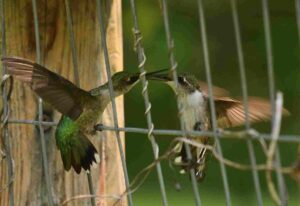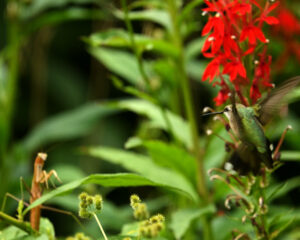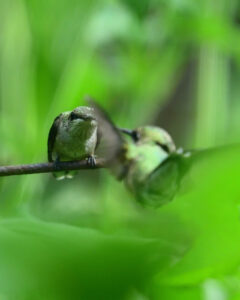Fencing Hummers
Article and photos by Joe Mish
A small patch of red monarda grew wild in one corner of the fenced in garden, survivors of at least one deer who decided their minty flavor to be a perfect palate cleanser. Much to the dismay of the late season hummingbirds, their over browsed food source left fewer opportunities for nourishment at a critical time, just prior to migration south.
The ownership of this last loaf of bread on the shelf, further intensified the territorial disputes that typically take place among hummers.
A young of the year male was feeding on the monarda, his dining strategy was to circle to the right, probing each scarlet tubule, then pulling back to hover for a moment, before repeating the flight pattern around the next floral head. Suddenly a second immature male appeared and the two began aerial acrobatics almost too fast to follow. Each bird disputed the property claim of the other. After close face to face sparring, they took off out of sight, separated by no more than a few inches.
It was impossible to differentiate one darting hummer from another, though the aggressor appeared to be the same bird, how many different challengers was in question.
Five minutes later another hummer appeared and began to feed with uncharacteristic speed, as if knowingly violating another’s territory, stealing as much as it could before the expected challenge from the self-proclaimed owner.
As expected, the challenge ensued. This time the interloper was inside the garden fence while the claim owner hovered outside the fence. So intense was their dispute, each floated in place commencing an aerial duel, with their needle like beaks, separated by the fence. It was a high noon showdown with unloaded weapons, as neither could be intimidated nor vanquished. The spectacle continued for a full minute until the aggressor realized the futility of his efforts and flew over the wire barrier to engage the trespasser. The two fencers immediately dropped their foils in favor of high aerial maneuvers to settle this territorial dispute.
While most hummingbird disputes consist of posturing, and aggressive aerial pursuits end harmlessly, another unexpected threat targeting hummers lurks among the flowers. The brown Asian preying mantis, an introduced species, will on occasion attempt to take and kill an unsuspecting hummer. Having read about the relationship of mantis and hummer, it seemed a rare occurrence of low probability until one early September afternoon.
A female hummer was feeding on the blooms of native red cardinal flower. Being aware of how individual hummers have their own feeding strategy, circling always to the right or left, pulling back for a moment before going on to the next flower or just moving on to the next bloom without a slightest hesitation, I noticed something odd about this hummer. She seemed to take sideways glances diverting attention from the business at hand. Sure enough, there was the focus of her attention. A light brown Asian preying mantis whose body length exceeded that of the hummer. Likewise the mantis appeared aware of the hummer and waited to strike. As the hummer worked the flower, she always maintained awareness of the mantis and at one point faced it directly. All ended well for the hummer, though it is easy to imagine a new fledged hummer falling victim to this insect predator.
As delicate and diminutive as hummingbirds appear, they are tough, aggressive creatures whose late summer-early fall southward migration defies the imagination. Hummers are as close to magic and myth as anything in nature. The ability to hover and maneuver with almost invisible wings and float in the air probing brilliantly colored flowers, while robed in iridescent feathers that seem more metallic than organic and change color with movement, surely earns mythical status. As is within a hummer’s personality, it will often initiate a face face introduction as it stays suspended in mid air inches from your nose, looking directly in your eyes. It is a wild thought that the hummer has captured the image of your face as readily as you hold his image in memory, to be recalled and reviewed, perhaps in a future pleasant dream, whose memory fades upon waking, leaving only the hint of a smile on your lips.
Author Joe Mish has been running wild in New Jersey since childhood when he found ways to escape his mother’s watchful eyes. He continues to trek the swamps, rivers and thickets seeking to share, with the residents and visitors, all of the state’s natural beauty hidden within full view. To read more of his writing and view more of his gorgeous photographs visit Winter Bear Rising, his wordpress blog. Joe’s series “Nature on the Raritan, Hidden in Plain View” runs monthly as part of the LRWP “Voices of the Watershed” series. Writing and photos used with permission from the author. Contact jjmish57@msn.com.
See more articles and photos at winterbearrising.wordpress.com




